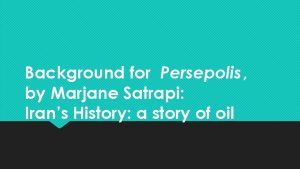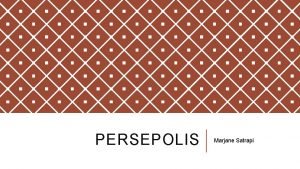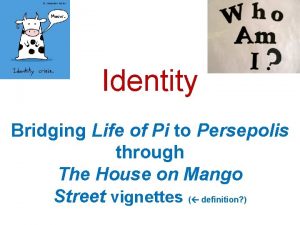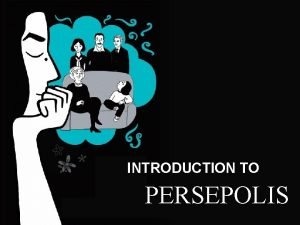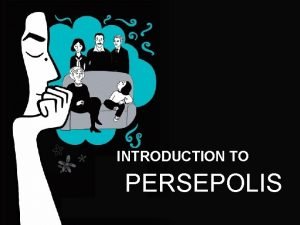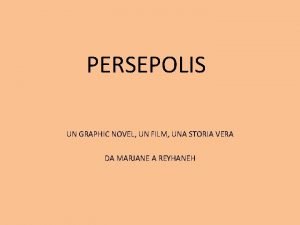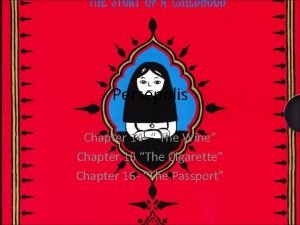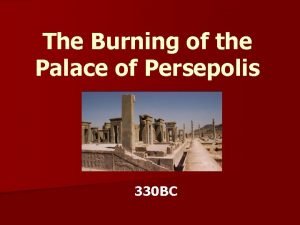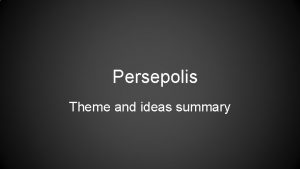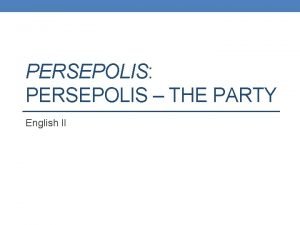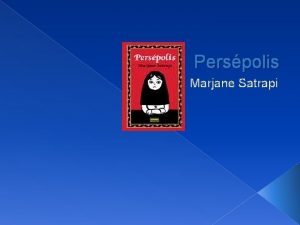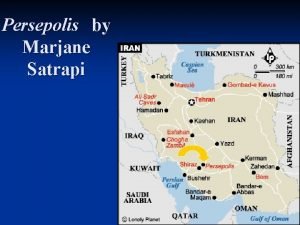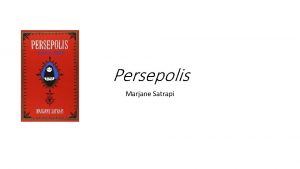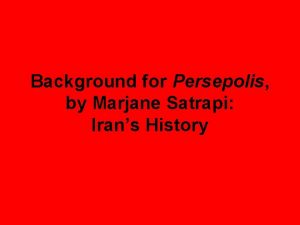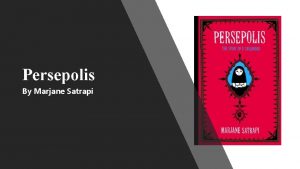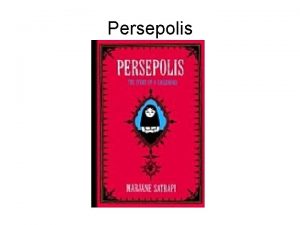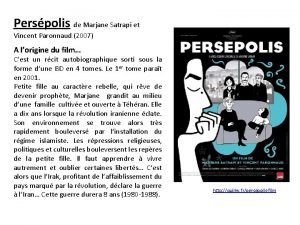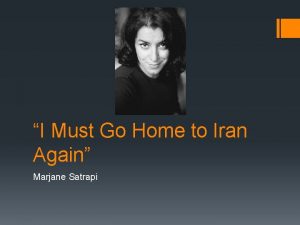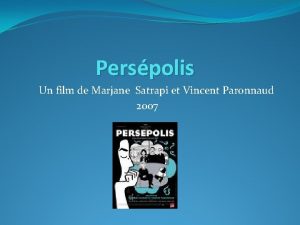Marjane Satrapis Persepolis Session aims To evaluate Satrapis











![Critique of Human Rights: “[W]hile the rhetoric of human rights has historically had a Critique of Human Rights: “[W]hile the rhetoric of human rights has historically had a](https://slidetodoc.com/presentation_image_h2/b6b2744d396912d633e59d9775536a0d/image-12.jpg)














- Slides: 26

Marjane Satrapi’s Persepolis Session aims: • To evaluate Satrapi’s portrayal of life in Iran for women and girls. • To analyse whether Satrapi succeeds in challenging or confirming stereotypes associating Iran with “fundamentalism, fanaticism, and terrorism”. • To critically engage with different theoretical interpretations of the Iranian women’s memoir genre. • To formulate an argument in response to the central themes explored in Persepolis.

Notices All abstracts can be found on the ‘Teaching and Reading Materials’ page – please review these, particularly if you’re chairing. Please review the new programme and check for any potential clashes. If you would like to arrange a meeting to discuss your assessments after the conference, please email me for an appointment. All office hours post conference will be by appointment only.

Identities “I was a Westerner in Iran, an Iranian in the West. I had no identity. I didn’t even know anymore why I was living. “— Satrapi Diasporic Iranian women’s literature has emerged as a response to the silences that have historically dominated Iranian women’s lives. For many Iranian women, writing has become a means to regain a sense of identity and make themselves visible against the backdrop of negative imagery associating Iran with “fundamentalism, fanaticism, and terrorism”, which has rendered them silent and invisible. We all have multiple identities. Please take two post-it notes and write down one identity that makes up who you are which is open, everyone can see it or everyone knows about it. Then on the other write down one identity that people don’t normally

Popular Narrative There is a popular narrative about women’s lives in Iran over the last forty years. It goes something like this: “During the Pahlavi Monarchy, women were on an upward trajectory. In a nation on the cusp of modernity, women actively participated. They were given the right to vote and were free to be in public without veils; they wore miniskirts on university campuses. Then came the Islamic Revolution in 1979, with Ayatollah Khomeini at the helm. The burgeoning freedoms for women were extinguished. The veil was required and institutions were segregated by gender. The Islamic Republic had thus achieved its goal of resurrecting the image of the traditional Muslim woman. ” This popular narrative presents half-truths, the real story is much more complicated, nuanced and less tidy.

Misconceptions 1. Before the Pahlavi monarchy, it is often assumed that Persian women were always suppressed by the religious and political establishment. 2. It is often asserted that Iranian women did not advocate for their freedom until recently. 3. It is contended that during the Pahlavi era, all women were liberated. 4. Some argue that during Khomeini era, women were totally oppressed. • What misconceptions are there about you or your identity? • How does this effect you?

Social and Cultural Contextualisation The declaration of the ‘war on terror’ after 9/11 has had a profound effect on the way in which Iranian women’s memoirs are constructed and consumed. There is a demand in the global market place for a narrative trajectory of an oppressed Muslim woman being liberated from Iran and Islam by escaping to the West to experience ‘Western’ freedom. Accordingly Iranian women writers have been accused of becoming “native informers”, “enlightened escapees”, and their memoirs “soft weapons”, because some critics believe they regurgitate the narrative of the oppressed woman liberated by their escape to the West, which can therefore be used to justify the need for colonial intervention. They often play on the idea of being silent and then liberated by the freedom of speech available to them now they are in the West.

Censorship In March 2013, the Chicago Public School district removed Persepolis from all seventh grade classrooms in the city. The school district defended its policy claiming it had not banned the book but removed it from the curriculum because it contained graphic language and images that were not appropriate for 12 -13 year olds. It has been banned in Iran, but in 2008 the animated film was screened a few times in Iran after sexual scenes were edited out. Persepolis was initially banned in Lebanon after some clerics found it to be "offensive to Iran and Islam". The ban was later revoked after an outcry in Lebanese intellectual and political circles.

The currency of silence Censorship has become part of the Iranian discourse of communication. This is why proverbs such as: ‘hefz-e aberu [to save face] Hefz-e zaher [to protect appearances] Ba sili surat-o sorkh negah dashtan [to keep the face red with a slap] Play a central role within Iranian family dynamics, even today. Milani explains “ Iranian women upheld the social conventions of silence and segregation because they knew that ‘public disclosure of any […] aspects of a woman’s life was considered an abuse of privacy and a violation of societal taboos […] for which punishments […] were many and varied’”

Paratextual reading The French theorist Gerard Genette argues, all literary works consist of accompanying elements, beyond their actual words and content, that ‘mediate the book to the reader’. These elements, which he calls ‘paratexts’ are essentially influenced by the socio-political and cultural situation of the time in which a book becomes part of the public domain. According to Genette there are two elements of paratextual reading, and we will be focusing on a peritextual reading for our next exercise. A peritextual reading will examine everything on the cover of the book. This reading will help readers to better situate and understand the book. Make a peritextual reading of Persepolis in relation to some of the other covers on display in pairs.


Article 10 ECHR: Right to Freedom of Expression (1) Everyone has the right to freedom of expression. This right shall include freedom to hold opinions and to receive and impart information and ideas without interference by public authority and regardless of frontiers. This Article shall not prevent States from requiring the licensing of broadcasting, television or cinema enterprises. (2) The exercise of these freedoms, since it carries with it duties and responsibilities, may be subject to such formalities, conditions, restrictions or penalties as are prescribed by law and are necessary in a democratic society, in the interests of national security, territorial integrity or public safety, for the prevention of disorder or crime, for the protection of health or morals, for the protection of the reputation or rights of others, for preventing the disclosure of information received in confidence, or for maintaining the authority and impartiality of the judiciary.
![Critique of Human Rights While the rhetoric of human rights has historically had a Critique of Human Rights: “[W]hile the rhetoric of human rights has historically had a](https://slidetodoc.com/presentation_image_h2/b6b2744d396912d633e59d9775536a0d/image-12.jpg)
Critique of Human Rights: “[W]hile the rhetoric of human rights has historically had a positive and liberating effect on societies, once rights become institutionalised as a central part of political and administrative culture, they lose their transformative effect and are petrified into a legalistic paradigm that marginalizes values or interests that resist translation into rights-language. In this way the liberal principle of the ‘priority of the right over the good’ results in colonization of political culture by a technocratic language that leaves no room for the articulation or realisation of conceptions of the good. ” Discuss M. Koskenniemi ‘The Effects of Rights on Political Culture’ in P. Alston (ed. ) The EU and Human Rights (Oxford: OUP, 1999)

“…I believe, profoundly, in the universality of the human spirit. Individuals everywhere want the same essential things: to have sufficient food and shelter; to be able to speak freely; to practice their own religion or to abstain from religious belief; to feel that their person is not threatened by the state; to know that they will not be tortured, or detained without charge, and that, if charged, they will have a fair trial. I believe there is nothing in these aspirations that is dependent upon culture, or religion, or stage of development. They are as keenly felt by the African tribesman as by the European city-dweller, by the inhabitant of a Latin American shanty-town as by the resident of a Manhattan apartment. ” Discuss R. Higgins, Problems and Process: International Law and How We Use It (Oxford: Clarendon Press, 1994) 96

“As currently constituted and deployed, the human rights movement will ultimately fail because it is perceived as an alien ideology in non-Western societies. The movement does not deeply resonate in the cultural fabrics of non-Western states, except among hypocritical elites steeped in Western ideas. In order to ultimately prevail, the human rights movement must be moored in the cultures of all peoples. ” Do you agree with this statement? Give reasons for your response? M. Mutua, ‘Savages, Victims and Saviors…’ 42 (2001) Harvard International Law Journal 201 at 208

Why are we discussing universal human rights? Does Satrapi’s life narrative become a valuable commodity? When Satrapi reveals the human rights violations in Iran does she enable her text becoming a “soft weapon”? What does Satrapi tell her readers about censorship?

Consider Satrapi’s portrayal of the chador – is it a symbol of British Houseoppression? of Lords Baroness Brenda Marjorie Hale in Begum v. Denbigh High School contends: “If a woman freely chooses to adopt a way of life for herself, it is not for others, including other women who have chosen differently, to criticise or prevent her. Judge Tulkens, in Sahin v Turkey draws the analogy with freedom of speech. The European Court of Human Rights has never accepted that interference with the right of freedom of expression is justified by the fact that the ideas expressed may offend someone. Likewise, the sight of a woman in full purdah may offend some people, and especially those Western feminists who believe that it is a symbol of her oppression, but that could not be a good reason for prohibiting her from wearing it. ”

The Veil A seminal Iranian women’s memoir Azar Nafisi’s Reading Lolita in Tehran has been accused of creating an image of veiled women that is nondescript and devoid of character. In her memoir, women become fully alive and human only when they cast the veil aside. Persepolis incorporates the veil in cartoons that characterise girls and women as distinctive individuals and human agents. Differences of emotion, personality, and physique among veiled Iranian girls and women remain vivid, this is an important statement for gender politics. How do you interpret the descriptions of the experience of Iranian girls and women wearing the veil in Iran? How does Satrapi explore the censoring of the body in her memoir?

Life in a convent in Austria and Life in Iran When Marji leaves Iran and goes to a convent in Austria we are invited to compare the veiled women and institutional surroundings of Catholicism with the Islamic Republic of Iran. How do these black and white images influence your perceptions of the veil? What political point is Satrapi making? If we reduce Iranian women to a struggle over the veil, either for or against, we are simplifying and inappropriately reproducing the errors of fundamentalism, represented by Satrapi in the mirror-imaging of life in the convent. How does Satrapi complicate our understanding of the veil?

Persepolis was a name given by the Greeks for what Persians used to call Takht-e-Jamshid (Jamshid’s Throne). It means “the city of Persians”. It was the ceremonial capital of the Persian Empire in 550 -330 BC until it was captured and destroyed by Alexander the Great in 330 BC when he invaded Persia. Centuries later, after the Arab conquest of the Persian Empire, Persepolis was eclipsed by the city of Shiraz. Although in ruins today, Persepolis remains a city central to Persian identity: it recalls a time when Iran was a powerful empire and when it was pre-Islamic. Since 1979, however, the Islamic Republic of Iran has tried to diminish Persepolis’ importance as part of a larger policy against Iran’s pre-Islamic heritage. By Satrapi naming her memoir with the western name for this pre-Islamic city central to Iranian identity, Satrapi identifies her work as both ‘Western’ and truly Persian, a political gesture aimed at an Islamic regime which refuses Iran’s diversity of

Group Activity – Applying Theory There are eight theoretical responses to Iranian women’s memoirs – work as a team to establish: how you might apply theory to the text what the problems might be in applying theory do you agree or disagree with theory explain any limitations try to work out how you might extend or further this reading

Constructing an Argument In your group work through as many of theoretical interpretations we have discussed in this session and write a paragraph using a PEA: Make a Point/argument Provide Evidence from the text and theory Analyse how theory applies, how does it further your understanding, what might be the limitations, how might you extend this reading? You will have colour coded post-it notes, use three post-it notes for each theory.

Marjane Satrapi introduces Persepolis, she begins “this old and great civilization has been discussed mostly in connection with fundamentalism, fanaticism, and terrorism. As an Iranian who has lived more than half of my life in Iran, I know that this image is far from the truth. ” How does Satrapi go about challenging this myth? How does Persepolis stereotypical views of Iran? these

Explore Satrapi’s representation of the chador. Provide an example from the text to support your view.

Do you think life narratives circulate as exotic commodities with an economic exchange value, or do they carry in their economy of exchange emotional value and aesthetic value, that shape how we think about others, and ourselves, and how we understand what it means to be human?

“Every situation offered an opportunity for laughs” (Satrapi 97). Explore the creative forms of resistance Marjane Satrapi uses to challenge the oppression she experiences.

Let’s make our own Zine!
 Marjane satrapi background
Marjane satrapi background Marjane satrapi background
Marjane satrapi background Persepolis background
Persepolis background Presentation
Presentation Session aims
Session aims Session aims
Session aims Persepolis lesson plans
Persepolis lesson plans Persepolis identity
Persepolis identity Persepolis kim wilde
Persepolis kim wilde Persepolis table
Persepolis table Persepolis table
Persepolis table Persepolis graphic novel
Persepolis graphic novel Hl essay line of inquiry examples
Hl essay line of inquiry examples Chapter 15 persepolis
Chapter 15 persepolis The burning of persepolis
The burning of persepolis Persepolis themes
Persepolis themes Persepolis burning
Persepolis burning Allusion in persepolis
Allusion in persepolis Persepolis chapter 8
Persepolis chapter 8 Persepolis questions
Persepolis questions Persepolis the party
Persepolis the party Persepolis introduction
Persepolis introduction Arithmetic expressions containing a null value evaluate to
Arithmetic expressions containing a null value evaluate to Psylotron
Psylotron Cramer's rule 3x3
Cramer's rule 3x3 Difference between expression and equation
Difference between expression and equation Evaluate square root
Evaluate square root
